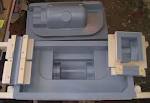INTRODUCTION
Casting is a manufacturing process by which a liquid material is usually poured into a mold, which contains a hollow cavity of the desired shape, and then allowed to solidify. The solidified part is also known as a casting, which is ejected or broken out of the mold to complete the process. Casting materials are usually metals or various cold setting materials that cure after mixing two or more components together; examples are epoxy, concrete, plaster and clay. Casting is most often used for making complex shapes that would be otherwise difficult or uneconomical to make by other methods.[1]
Casting is a 6000 year old process.[2] The oldest surviving casting is a copper frog from 3200 BC.[2]
PATTERN:
pattern is the replica of the part to be cast and is used to prepare the mould cavity.Patterns are made of wood or metal.There are several types of patterns like
loose pattern: It is made in one piece, usually from wood, and is used for castings numbering up to 100.
Gated pattern : this is simply one or more than one loose pattern with attached gates and runner and provides a channel through which the molten metal can flow from the pouring sprue to the mould cavity.

Match plate pattern : this pattern is made in two halves mounted on both sides of a match plate(wood or metal)

cope and drag pattern : Here,the cope and drag halves of a split pattern are separately mounted on two match plates .Thus ,the cope and drag flasks are made separately and brought together to produce the complete mould.

Sweep pattern : this is normally made of woods ,it is used to generate surfaces of revolution in large castings,and to prepare moulds out of paste-like materials.

Skeleton pattern : This is consists of a wooden frame outlining the shape of the casting .It is used to guide the moulder for hand-shaping the mould and for large castings havings simple geometrical shapes.
Casting is a manufacturing process by which a liquid material is usually poured into a mold, which contains a hollow cavity of the desired shape, and then allowed to solidify. The solidified part is also known as a casting, which is ejected or broken out of the mold to complete the process. Casting materials are usually metals or various cold setting materials that cure after mixing two or more components together; examples are epoxy, concrete, plaster and clay. Casting is most often used for making complex shapes that would be otherwise difficult or uneconomical to make by other methods.[1]
Casting is a 6000 year old process.[2] The oldest surviving casting is a copper frog from 3200 BC.[2]
PATTERN:
pattern is the replica of the part to be cast and is used to prepare the mould cavity.Patterns are made of wood or metal.There are several types of patterns like
loose pattern: It is made in one piece, usually from wood, and is used for castings numbering up to 100.
Gated pattern : this is simply one or more than one loose pattern with attached gates and runner and provides a channel through which the molten metal can flow from the pouring sprue to the mould cavity.

Match plate pattern : this pattern is made in two halves mounted on both sides of a match plate(wood or metal)

cope and drag pattern : Here,the cope and drag halves of a split pattern are separately mounted on two match plates .Thus ,the cope and drag flasks are made separately and brought together to produce the complete mould.

Sweep pattern : this is normally made of woods ,it is used to generate surfaces of revolution in large castings,and to prepare moulds out of paste-like materials.

Skeleton pattern : This is consists of a wooden frame outlining the shape of the casting .It is used to guide the moulder for hand-shaping the mould and for large castings havings simple geometrical shapes.


No comments:
Post a Comment